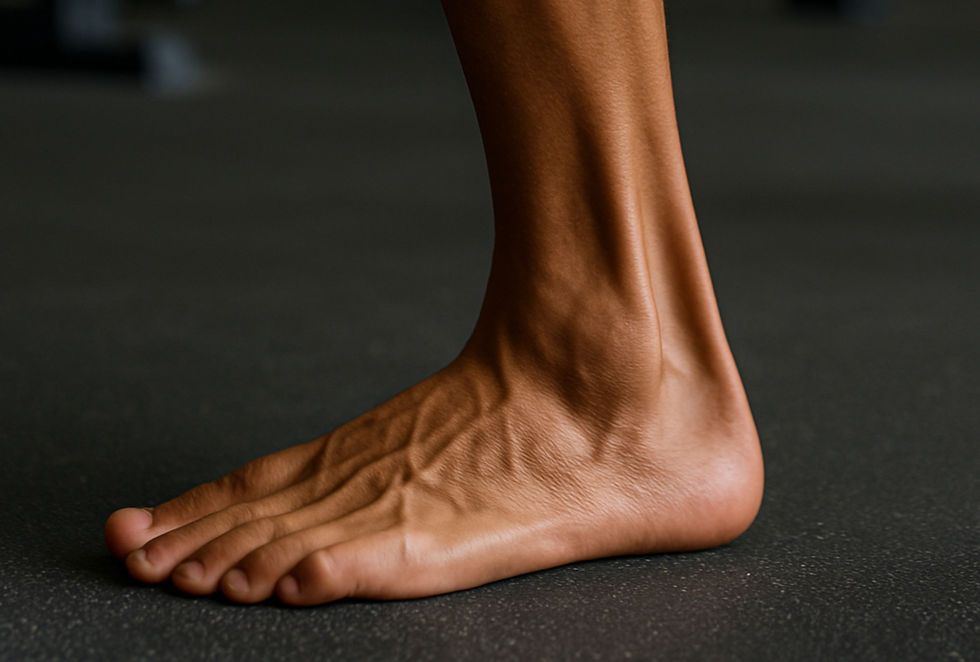Strong Ankles, Strong Athlete: The Truth About Ankle Mobility
- FitnessFirstAcademy

- Apr 24
- 3 min read

By Fitness First Academy
At Fitness First Academy, we know that performance starts from the ground up—and that includes your ankles. Whether you’re sprinting down the field or hitting a squat PR, ankle mobility and stability are make-or-break components of athletic performance.
Most people assume ankle issues are just about tight calves—but there’s more to it than that. Based on insights from Dr. Emily Splichal’s All About the Ankle course for NASM, combined with leading expert opinions, here’s what every athlete and coach needs to know.
Why Ankle Mobility Is So Important
The ankle plays three key roles:
Mobility (so your body can move freely)
Stability (to prevent injury)
Power production (especially for sprinting and change of direction)
If any of those elements are off, everything upstream—knees, hips, spine—gets compromised.
Common Causes of Limited Ankle Mobility
Mobility restrictions can come from more than just tight calves:
Soft Tissue Tightness – Like tight gastrocnemius, soleus, and Achilles tendon
Osseous (Bone) Restrictions – Like ossification near the talus or tibia, which physically blocks dorsiflexion
Previous Injuries – Multiple ankle sprains? You may have permanent ligament laxity and a forward-shifted talus
Footwear – Rigid or elevated shoes (like modern sneakers) can shut down natural mobility and proprioception
Neurosensory Control: The Overlooked Side of Ankle Health
Dr. Splichal’s course highlights how most rehab programs only focus on proprioception—balance and joint awareness. But that’s only half the equation.
You also need mechanoception—the ability to feel vibration, pressure, and texture under your feet. This sensory input is critical for joint stability and reaction speed, especially during explosive movements.
Functional Coupling: Not All Motion Is Created Equal

The ankle joint has natural movement pairings:
Dorsiflexion + Abduction
Plantarflexion + Adduction
If you see excessive sideways or rotational movement during squats or lunges, that’s likely a compensation for something missing—often mobility or joint centration.
Tools You Can Use to Restore Ankle Function
At Fitness First Academy, we recommend a layered approach using tools supported by Dr. Splichal and other leading professionals:
Mobility Tools
Neuro Ball – For releasing the plantar fascia and soleus
Slant Board Squats – To train deeper dorsiflexion
Plantar Fascia Board – For controlled tissue release
Posterior Talar Mobilizations – To unstick a forward-shifted talus
Sensory Stability Drills
Short Foot Activation – Reconnect your arch and nervous system
Toe Spacers – Promote natural alignment
Sensory Stick Stack – Teaches feedback and pressure tolerance
Wobble Board Work + Kinesis Board Lever Balancing – Train micro-adjustments, proprioception, and dynamic control
Strength & Power Exercises
Heel Squeeze with Ball – For deep foot-to-hip engagement
Loaded Plantarflexion with External Rotation – Reinforces power and hip linkage
Additional Expert Insights
Fitness First Academy doesn’t just rely on trends—we draw from the world’s top thought leaders in movement science:
Dr. Kelly Starrett (The Ready State) – Joint mobilization and stability training
Dr. Irene Davis (Harvard Medical School) – Barefoot running and gait biomechanics
Dr. Patrick McKeon (Foot-Core System) – Sensory-driven foot strength
Dr. Christopher Powers (USC) – Hip-ankle-knee biomechanics and performance
Dr. Emily Splichal (EBFA Global) – Neurosensory foot science and mobility restoration
Final Thoughts: Don’t Stretch What You Can’t Control
If you’re dealing with stiffness, don’t just stretch blindly. Identify whether your limitation is muscular, bony, or neurological. Then choose the right tool for the job.
Your ankle doesn’t just need to move—it needs to move with purpose, precision, and power.
References
Splichal, E. (2025). All About the Ankle [NASM CEU Course]
Starrett, K. (2013). Becoming a Supple Leopard. Victory Belt Publishing
Davis, I. S., et al. (2010). The mechanics of barefoot running. Harvard University Research Archive
McKeon, P. O., et al. (2015). The foot core system: A new paradigm for understanding intrinsic foot muscle function. Br J Sports Med
Powers, C. M. (2003). The influence of abnormal hip mechanics on knee injury. JOSPT

About the Author
Alexander Morrow is a NASM Certified Personal Trainer, ACE Certified Personal Trainer, ACE Certified Group Fitness Instructor, NCSF Certified Strength & Conditioning Coach & ACE Fitness Nutrition Specialist with a passion for helping people reach their fitness goals. With a focus on strength training and functional movement, he believe in building a strong, capable body from the inside out. Connect with @FitnessFirstAcademyF1A on Instagram or visit www.FitnessFirstAcademy.com/blog for more training tips and inspiration.
Get Ready to Feel Strong and Powerful!



Comments